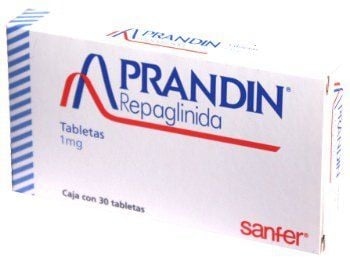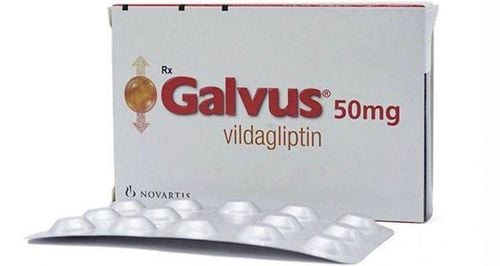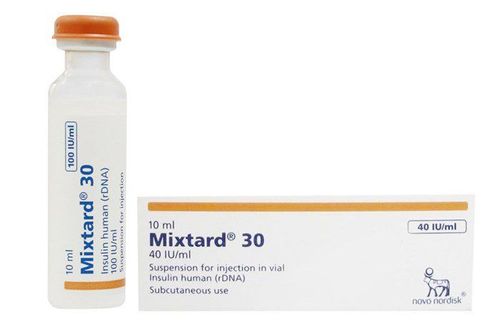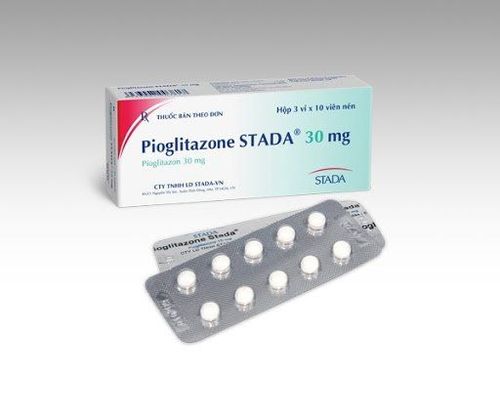This is an automatically translated article.
Onglyza is a new antidiabetic drug, which works by inhibiting the enzyme that breaks down two natural hormones in the body, which are released after eating, in order to reduce the amount of glucose quickly. Use of this drug prolongs the hypoglycaemic effect after meals or after glucose administration.
1. What is the effect of Onglyza?
What does Onglyza do? Onglyza medicine has saxagliptin ingredients, is prepared in the form of 2.5 mg and 5 mg film-coated tablets. The active ingredient Saxagliptin belongs to the group of drugs that inhibit the DPP enzyme. For patients with type 2 diabetes, when using Onglyza will inhibit DPP-4 enzyme activity for 24 hours. Following oral or postprandial glucose testing, inhibition of DPP-4 results in a 2- to 3-fold increase in blood levels of the active hormones GLP-1 and GIP, both of which decrease glucagon levels. blood and increased glucose-dependent insulin release from pancreatic beta cells.
Increases in insulin levels and decreases in glucagon levels are associated with lower fasting glucose levels and help lower glucose levels after oral glucose administration or after a meal.
2. Indications and contraindications of Onglyza
Indications:
Onglyza is indicated for use in the following cases:
Monotherapy to support diet and exercise to help control blood glucose in adult patients with diabetes type 2 . Can be used in combination with other drugs to control blood sugar in patients with type 2 diabetes. Contraindications:
Onglyza is contraindicated in the following cases:
Hypersensitivity to the active ingredient Saxagliptin or any excipients which medicine. It should not be used in patients with type 1 diabetes or diabetic keto-acidosis, because the drug is not effective in these subjects.
3. Dosage and usage of Onglyza
How to use: Onglyza is used orally, can be taken with or without meals. Patients should not break or crush Onglyza tablets before taking them.
While taking the drug should be combined with a diet to increase the effectiveness of the drug.
Dosage:
The recommended dose of Onglyza is 2.5 mg to 5 mg orally once a day. Patients with renal impairment: No dose adjustment of Onglyza is required for patients with mild renal impairment (creatinine clearance > 50 ml/min). Using Onglyza at a dose of 2.5 mg once a day for patients with moderate or severe renal impairment and end-stage renal failure requiring hemodialysis, Onglyza should be used after hemodialysis. . Since the dose of Onglyza should be limited to 2.5 mg/day based on renal function, renal function should be assessed prior to initiation of Onglyza therapy and periodically thereafter renal function should be monitored. Concomitant Use with Strong Inhibitors of CYP3A4/5: The usual dose of Onglyza is 2.5 mg once daily when co-administered with strong inhibitors of cytochrome P450 3A4/5 (CYP3A4/5). ) such as ketoconazole, itraconazole, atazanavir, clarithromycin, indinavir, nelfinavir, nefazodone, ritonavir, saquinavir and telithromycin. Concomitant use with insulin secretagogues (e.g. sulfonylureas) or with insulin: When Onglyza is used concurrently with these drugs, a low dose of the insulin secretagogue or insulin should be initiated to minimize the risk of hypoglycaemia. Overdose and missed dose:
Overdose: In clinical trials in healthy subjects, no overdose has been observed. In the event of an overdose where the patient has urgent signs, appropriate supportive measures should be applied based on the specific clinical condition of the patient. Saxagliptin and its active metabolite can usually be eliminated by hemodialysis. Missed dose: If you miss a dose of Onglyza, take it as soon as you remember. However, if it is almost time for your next dose, skip the missed dose and continue taking your next dose at the scheduled time. Note: Do not take double the prescribed dose.
4. Undesirable effects of the drug Onglyza
When using Onglyza you may experience unwanted effects, including:
Runny nose, sore throat, headache, painful urination, abdominal pain, nausea, vomiting, diarrhea, flatulence. Some side effects that can be serious include: rash, hives, swelling of the face, lips, tongue or throat, trouble breathing or swallowing, hoarseness; Severe hypersensitivity reactions such as anaphylaxis, angioedema or exfoliative skin conditions; Acute pancreatitis. When experiencing side effects of the drug, you need to stop using it and notify your doctor or go to the nearest medical facility for timely treatment.
5. Note when using Onglyza
In the process of using Onglyza, patients should note some of the following issues:
Before using the drug, you need to tell your doctor about your medical history, history of drug allergies. Acute pancreatitis in patients receiving Onglyza has been reported. Therefore, after initiation of therapy, patients should be carefully monitored for signs and symptoms of pancreatitis such as abdominal pain, nausea, elevated serum amylase levels, etc. If pancreatitis is suspected, Patients should immediately discontinue Onglyza and institute appropriate control measures. It is not known if patients with a history of pancreatitis using Onglyza may be at increased risk for pancreatitis, but caution is still needed. When used with drugs that cause hypoglycemia: When Onglyza is used in combination with a sulfonylurea or with insulin, the frequency of confirmed cases of hypoglycemia is higher than when using placebo in combination with a sulfonylurea or with insulin. Therefore, it is necessary to use low doses of insulin secretagogues to minimize the risk of hypoglycemia when used in combination with Onglyza. Serious hypersensitivity reactions in patients receiving Onglyza have been reported post-marketing. These reactions include anaphylaxis, vasculitis, and exfoliative skin reactions. These reactions usually occur within the first 3 months of treatment with Onglyza, in some cases after the first dose. If a severe hypersensitivity reaction is suspected, you should discontinue Onglyza, initiate appropriate treatment, and seek alternative treatment for diabetes. Use with caution in patients with a history of angioedema with other dipeptidy peptidase-4 (DPP4) inhibitors, as it is not known whether these patients may develop angioedema with Onglyza. Ability to drive and use machines: No studies on the effects of this drug on the ability to drive and use machines have been performed. However, when driving or operating machinery, it should be noted that dizziness has been reported during treatment with saxagliptin. Pregnancy : The drug category for pregnant women is group B. Currently, there are not enough controlled studies on the use of saxagliptin in pregnant women. Therefore, Onglyza and other antidiabetic drugs should not be used during pregnancy, but should be used as a form of treatment that has been shown to be safe. Lactation: Saxagliptin was excreted in the milk of lactating rats at a ratio of approximately 1:1 to plasma concentrations. It has not been determined whether saxagliptin is excreted in human milk. Because many drugs are excreted in human milk, extreme caution should be exercised when Onglyza is administered to a nursing woman. Drug Interactions: Onglyza may cause interactions with inhibitors of CYP3A4/5, which increase saxagliptin concentrations. Storage: Store Onglyza in a tightly closed container, at a temperature below 30 degrees Celsius. Keep the medicine out of the reach of children. Do not use when the medicine has expired or shows signs of damage. Onglyza is used under the direction of a doctor. Therefore, to be on the safe side, you should consult your doctor before using. If any unusual problems occur, consult your doctor for advice and support.
Follow Vinmec International General Hospital website to get more health, nutrition and beauty information to protect the health of yourself and your loved ones in your family.
Please dial HOTLINE for more information or register for an appointment HERE. Download MyVinmec app to make appointments faster and to manage your bookings easily.













